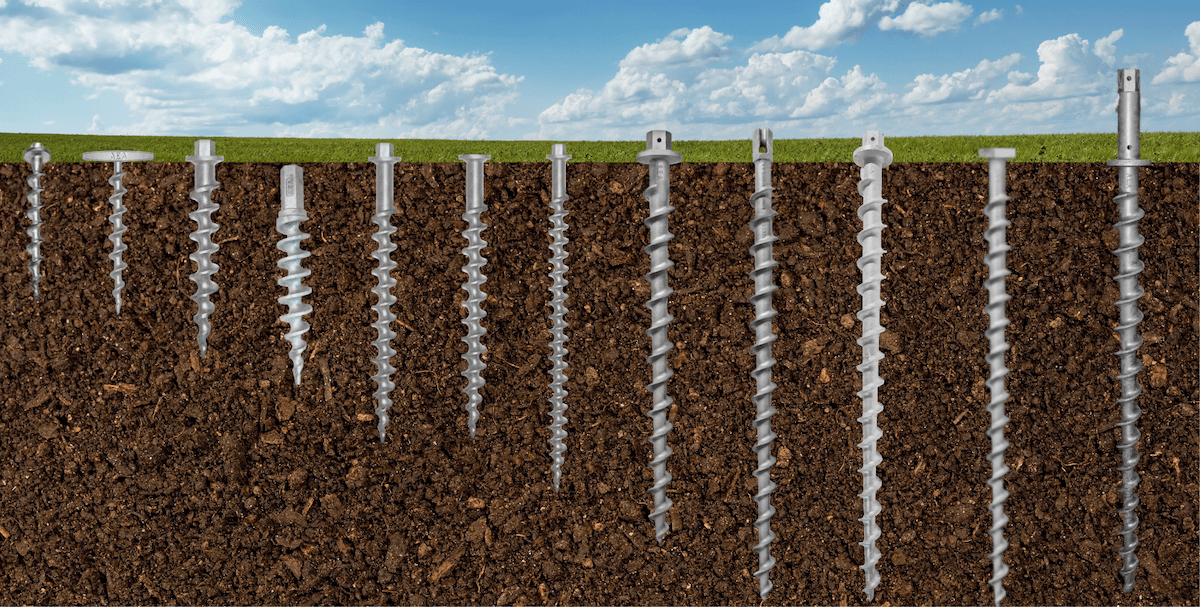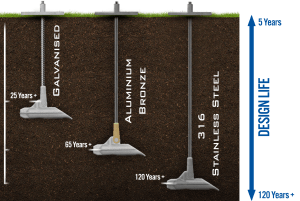How Heavy-Duty Earth Anchors Job: A Comprehensive Overview to Dirt Anchoring Solutions
Heavy-duty Earth anchors play an important role in offering stability and assistance in numerous building applications. By embedding deeply right into the ground, they stand up to vertical and side pressures properly. Various kinds of supports deal with various soil conditions, making them versatile. Comprehending their technicians and installation methods is crucial for maximizing performance. What elements influence their effectiveness, and exactly how do they compare to traditional approaches? The responses may shock you.
Recognizing Heavy-Duty Earth Anchors
Heavy-duty Earth anchors work as important parts in different building and landscaping projects, supplying stability and support in tough soil conditions. These anchors function by being installed into the ground, where they resist lateral and upright pressures. Their style enables secure add-on to structures, ensuring they remain anchored versus soil activity or outside loads.The performance of sturdy Earth supports largely depends on the kind of dirt and the support's setup depth. Proper installation strategies are crucial, as they identify the support's holding capability. Ecological factors, such as moisture and freeze-thaw cycles, can additionally affect performance.These anchors are frequently utilized in applications ranging from securing fences and retaining walls to stabilizing short-term frameworks during negative weather. Comprehending the concepts behind heavy-duty Earth anchors is vital for specialists looking for to boost the resilience and safety and security of their jobs.
Types of Heavy-Duty Earth Anchors
Numerous sorts of durable Earth anchors are made to satisfy certain demands based on dirt problems and project demands. Helical anchors, featuring screw-like blades, work in softer dirts, offering high load capabilities and simple installation. Driven anchors, which are hammered into the ground, are ideal for rough surfaces and supply prompt tons support. Tie-back anchors are frequently made use of in keeping wall surface applications, permitting for side assistance by securing right into the ground at an angle. Another kind is the cast-in-place support, perfect for concrete applications, as they are integrated right into foundations for boosted security. Soil screw supports are functional options that can be made use of in various soil kinds, offering reliable tension and compression abilities. Each type offers distinctive applications, guaranteeing stability and security in construction and landscaping tasks. Understanding these alternatives enables educated decisions in picking the appropriate Earth securing remedy.
The Mechanics of Dirt Anchoring

Understanding the technicians of soil anchoring needs an examination of numerous types of Earth supports and their installment techniques. Each support type presents unique qualities that affect its effectiveness in various dirt problems. Proper installment methods are essential for making best use of the securing system's security and efficiency.
Sorts Of Earth Anchors
Earth supports, necessary parts in dirt anchoring systems, been available in a number of types, each developed for specific applications and dirt conditions. The most typical kinds consist of screw supports, which are turned right into the ground, supplying strong lateral resistance. Helical anchors feature blades that enable reliable installation in numerous dirt kinds, making them suitable for both momentary and long-term applications. Driven anchors, generally made from steel, are inculcated the soil and are reliable in rocky or thick settings. Auger supports use a helical design to facilitate installation in softer dirts. Plate anchors are composed of a level plate hidden horizontally, dispersing lots over a bigger location, ideal for applications calling for high tons capacities in cohesive dirts.
Installation Techniques Discussed
Correct setup strategies are vital for the efficiency of dirt anchoring systems. The process usually starts with website assessment, validating the chosen place can support the support's load. After figuring out the proper support kind, appropriate hole deepness and angle should be developed. The installation includes driving the anchor right into the ground using customized tools, such as hands-on or hydraulic vehicle drivers, to attain finest embedment. Post-installation, tensioning the anchor is crucial to ensure stability; this is frequently validated with lots screening. Additionally, bordering soil conditions need to be checked to protect against variation. Complying with these strategies not only boosts the anchor's performance but likewise prolongs its life expectancy, supplying trusted support for different applications.
Applications of Heavy-Duty Earth Anchors
While durable Earth anchors are usually related to construction and landscaping, their flexibility encompasses a selection of applications throughout different markets. In civil design, they offer crucial assistance for maintaining wall surfaces, making certain stability in areas prone to soil erosion. The marine field makes use of these supports for securing anchors and marinas, stopping movement brought on by tides and currents. Additionally, in the telecom sector, durable Earth supports are significant for supporting cell towers and other tall frameworks against wind pressures. Agricultural applications additionally profit, as these anchors can protect structures like greenhouses and livestock fence, guaranteeing they hold up against rough weather. In sustainable energy tasks, such as wind farms, Earth anchors play a vital function in safeguarding wind turbine structures, improving general safety and efficiency. This broad variety of applications highlights the flexibility and integrity of durable Earth anchors throughout numerous fields.
Advantages Over Typical Anchoring Techniques
Although traditional anchoring approaches have long been depended upon for security, durable Earth anchors use significant benefits that enhance performance and performance. One major advantage is their exceptional load-bearing capacity, which permits them to stand up to greater pressures without failing. This strength makes them excellent for demanding applications, such as in building and construction and energy installations.Additionally, durable Earth anchors are made for deeper installment, supplying higher security in various soil conditions, including sandy or loosened soils. Their resistance to corrosion and ecological aspects assures a much longer life expectancy and decreased maintenance costs contrasted to traditional methods.Moreover, these supports can be installed with marginal disruption to the surrounding area, maintaining the stability of the landscape. In general, durable Earth supports offer a trusted and effective option for anchoring needs, exceeding the restrictions often associated with standard anchoring techniques.
Installation Refine and Best Practices
The installation procedure for dirt securing remedies begins with thorough preparation and website analysis to assure peak performance. Following this, a step-by-step installation overview provides clear guidelines for reliable execution (soil anchoring solutions). Complying with these ideal methods is necessary for achieving trustworthy and durable anchoring results
Prep Work and Site Analysis
Efficient preparation and extensive website analysis are vital action in the installation of soil securing solutions. Before installment, the soil kind must be evaluated to determine its bearing capability and suitability for anchoring. Carrying out read more a geotechnical survey can offer essential information regarding dirt structure, wetness levels, and possible ground activity. Furthermore, recognizing existing structures, greenery, and utilities is necessary to stay clear of disturbance during installment. The area must be free from particles and challenges to guarantee secure access for tools. Weather need to likewise be kept track of, as adverse try this conditions can affect both safety and installation efficacy. By thoroughly preparing the site and examining all relevant aspects, the probability of effective support efficiency is considerably raised.
Step-by-Step Installation Overview
A complete setup process is vital for achieving perfect performance of dirt securing services. The installment begins with picking the suitable support type and assuring the site is clear of debris. Next, correct opening placement is figured out based on tons demands. As soon as the location is developed, openings are drilled to the specified deepness and diameter using the appropriate devices. The anchor is then placed right into the opening, making sure it is lined up appropriately. After securing the anchor, soil is backfilled and compacted to improve stability. It is vital to adhere to producer guidelines throughout the process. A post-installation examination confirms that the anchors are effectively located and functioning as intended, giving dependable assistance for the designated application.

Maintenance and Evaluation of Earth Anchors
Normal upkeep and assessment of Earth anchors are essential for making sure long-lasting performance and stability. Routine checks permit the very early detection of problems such as corrosion, loosening up, or dirt movement. Examiners need to try to find indicators of rust or deterioration on the anchor elements, especially at the connection points. In addition, the bordering dirt needs to be assessed for disintegration or changes in wetness material, which can impact support effectiveness.It is recommended to establish a routine assessment timetable, preferably at the very least annually, depending on ecological conditions. Throughout inspections, all noticeable components must be cleansed to remove dirt or particles that can conceal prospective issues. Any kind of indicators of distress, such as turning structures or uncommon settling, need to prompt instant evaluation. Proper documentation of inspections can assist in tracking anchor efficiency over time and facilitate prompt upkeep activities, guaranteeing the supports remain dependable and practical.
Frequently Asked Concerns
What Materials Are Heavy-Duty Earth Anchors Commonly Made From?
Sturdy Earth anchors are commonly created from durable products click to read such as galvanized steel or stainless-steel, ensuring toughness and resistance to rust. These products supply resilient assistance and security in numerous dirt conditions and applications.
Just How Do Dirt Problems Affect Anchor Efficiency?
Soil problems considerably affect support performance. Aspects such as dirt kind, moisture material, and compaction affect the support's hold and security, with cohesive dirts often giving far better resistance than sandy or loose soils, affecting overall performance.
Can Heavy-Duty Earth Anchors Be Recycled After Removal?
Sturdy Earth anchors can be reused after elimination, provided they are examined for damage and wear. Correct cleansing and upkeep boost their durability, making sure efficient efficiency in succeeding installations when conditions enable risk-free reinstallation.
What Are the Ecological Influences of Making Use Of Earth Anchors?
The environmental impacts of using Earth supports consist of potential dirt disturbance, interruption of neighborhood ecological communities, and possible contamination of groundwater. Nonetheless, if used responsibly, their benefits typically exceed these issues, promoting security in numerous applications.
Exactly how Do I Select the Right Anchor for My Task?

Comments on “Master the Art of Installing construction site anchors on Active Worksites”